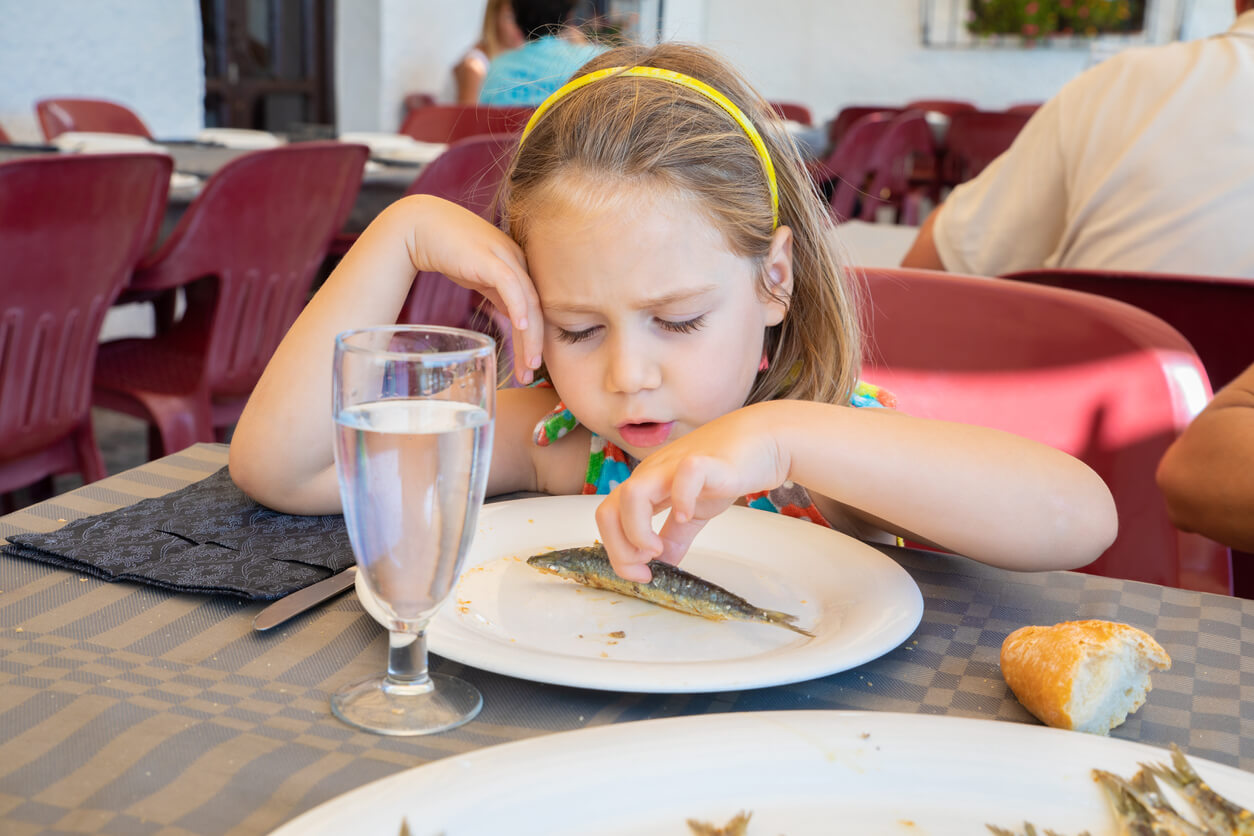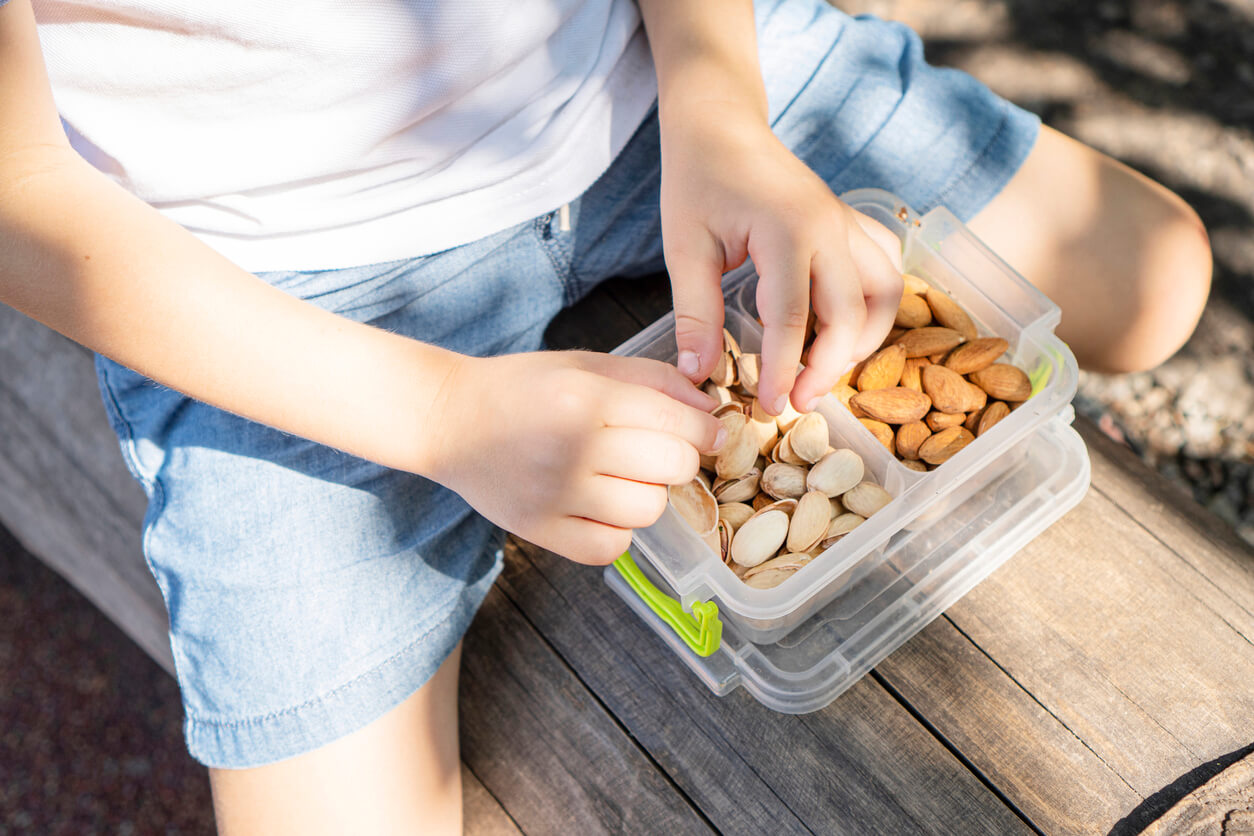Foods for Childhood Anemia

Nutritional anemia is considered one of the most common blood diseases in children. It’s often due to a diet low in iron, which causes fatigue, weakness, headache, and, in severe cases, psychomotor and intellectual disorders. Therefore, it’s paramount to include foods for childhood anemia in their diet to correct this condition.
Keep reading for a list of the top foods to prevent and treat childhood anemia. Nutritional prevention of this disease is a guarantor of the better health and performance of our children.
Read also: 7 Foods to Fight Childhood Anemia
What is anemia?
The World Health Organization defines anemia as a condition in which the hemoglobin content of the blood is below normal for a given age, sex, and physiological state. According to this organization, 25.4 % of preschoolers and 47.4 % of schoolchildren suffer from this disorder.
Hemoglobin is a blood protein that contains iron in its structure. It forms the red blood cells that carry oxygen to various tissues in the body. When iron intake is deficient or poorly absorbed, hemoglobin drops and nutritional anemia occurs.
Symptoms
To identify anemia in children, we must be aware of the following signs and symptoms:
- Weakness
- Tiredness and constant sleepiness
- Pallor
- Irritability
In more severe and chronic cases, shortness of breath, swelling of the hands and feet, headaches, dizziness, fainting, and rapid heart rate may occur. Cognitive impairment may also appear over time.
Discover the foods for childhood anemia
Some foods in particular are excellent sources of iron, so their consumption should be increased in children who are facing nutritional anemia. However, we must be attentive to whether it’s absorbable iron or not. It can be in heme or non-heme form, depending on its origin. But what does this mean?
- Heme iron: This is incorporated into the heme group of hemoglobin and myoglobin and can be absorbed between 20 and 30%. It’s found in foods of animal origin, with the exception of milk and cheese.
- Non-heme iron: It’s found in the form of salts or as part of molecules that trap it and only 3 to 8% is absorbed. It predominates in vegetables.
On the other hand, it’s also important to know how to combine the foods that provide iron. For example, while calcium decreases its absorption, vitamin C increases it significantly.
What are the main food sources of iron?
Here’s a list of foods that are the main sources of iron.

Fish, mollusks, and crustaceans
In the case of fish, iron values are similar to other white meats, between 1 and 2%. However, canned sardines can reach almost 4 milligrams of heme iron.
Some mollusks and crustaceans are exceptional as a source of iron. For example, according to the Spanish Nutrition Foundation, clams provide 24 milligrams per percent, and oysters up to 7 milligrams. In addition, snails exceed 10 milligrams and mussels 4.5 milligrams per 100 grams of the edible parts of the animals.
White and red meats
White meats such as turkey and chicken contain between 1 and 2 milligrams per percent of iron. Red meats can have up to 3 milligrams. Although it’s true that it’s not a very high value, white and red meats contain heme-type iron, which is absorbed in high proportion.
Viscera
All viscera are considered an excellent source of iron. Calf liver provides 7 milligrams, while the kidneys provide 6 and the heart about 5 milligrams per percent. These values manage to cover almost three-quarters of the daily requirements of children. Although pork liver, which provides 15 milligrams per 100 grams of meat, doubles the requirements.
Legumes
Among vegetables, legumes such as lentils, beans, chickpeas, peas, and soybeans, among others, are considered the best sources of iron. Their values range between 5 and 7 milligrams per percent. However, as a 2020 article reveals, the presence of phenols, such as tannins and phytic acid, which form salts with several minerals, limit the availability of iron for absorption.
Fortunately, some processes, such as soaking, germination, and fermentation of the seeds, manage to activate certain enzymes inside the grain that break the bonds and release the iron. At the same time, it’s a good idea to soak grains and eat sprouts or sprouted legumes to improve iron absorption in childhood anemia.
Green leafy vegetables
Among vegetables, those that provide more iron in increasing order are watercress, chard, and spinach. Values range from 2 to 4 milligrams per 100 grams of food. However, in green leaves, there are oxalates that prevent complete absorption. For example, phytic acid is present in these vegetables. With this in mind, cooking the leaves can improve the availability of this mineral.

Nuts
Nuts are an excellent source of proteins, healthy fats, antioxidants, and minerals. Among the latter, iron values stand out, ranging between 5 and 7 milligrams per 100 grams.
In addition to their nutritional value, children love the taste, texture, and aromas of nuts. Those with the highest iron content are pistachios (7 mg %), sunflower seeds (6.4 mg %), pine nuts (5.6 mg %), hazelnuts, and almonds (both at 4 mg %).
Brewer’s yeast
Yeast is a living microorganism used to ferment fruits and cereals. It contains a high proportion of iron and reaches 20 milligrams per 100 grams. It’s used to make pizzas, breads, and other fermented products. It can also be used to enrich some fruit drinks, sauces, creams, or soups.
Read also: 6 Iron-Rich Foods for Babies and Children
How to take advantage of the iron in food
According to the magazine Farmacia Profesional, the bioavailability of iron can be improved with some tips that we’ll give you below:
- Increase the consumption of fruits rich in vitamin C, such as guava, strawberries, kiwi, or citrus fruits, among others. Above all, when eating legumes and vegetables. Vitamin C increases the absorption of iron.
- Avoid products that inhibit its absorption, such as coffee, tea, and chocolate. Caffeine and theine trap iron and reduce its absorption by 60%. For this reason, they shouldn’t be ingested with meals.
- Avoid foods that provide insoluble fiber, such as wheat bran, whole grains, and whole wheat bread and pasta, among others. This fiber also traps iron.
- Consuming dairy products outside of those meals that provide the highest proportion of iron.
Increasing iron intake is key
When faced with anemia in children, the first action is to talk to a pediatrician and nutritionist for guidance on food. It’s crucial to increase the consumption of foods rich in bioavailable iron, such as meats, liver, canned sardines, nuts, legume sprouts, mollusks, and crustaceans. Include them in new and attractive preparations to make them tempting for the child.
Nutritional anemia is considered one of the most common blood diseases in children. It’s often due to a diet low in iron, which causes fatigue, weakness, headache, and, in severe cases, psychomotor and intellectual disorders. Therefore, it’s paramount to include foods for childhood anemia in their diet to correct this condition.
Keep reading for a list of the top foods to prevent and treat childhood anemia. Nutritional prevention of this disease is a guarantor of the better health and performance of our children.
Read also: 7 Foods to Fight Childhood Anemia
What is anemia?
The World Health Organization defines anemia as a condition in which the hemoglobin content of the blood is below normal for a given age, sex, and physiological state. According to this organization, 25.4 % of preschoolers and 47.4 % of schoolchildren suffer from this disorder.
Hemoglobin is a blood protein that contains iron in its structure. It forms the red blood cells that carry oxygen to various tissues in the body. When iron intake is deficient or poorly absorbed, hemoglobin drops and nutritional anemia occurs.
Symptoms
To identify anemia in children, we must be aware of the following signs and symptoms:
- Weakness
- Tiredness and constant sleepiness
- Pallor
- Irritability
In more severe and chronic cases, shortness of breath, swelling of the hands and feet, headaches, dizziness, fainting, and rapid heart rate may occur. Cognitive impairment may also appear over time.
Discover the foods for childhood anemia
Some foods in particular are excellent sources of iron, so their consumption should be increased in children who are facing nutritional anemia. However, we must be attentive to whether it’s absorbable iron or not. It can be in heme or non-heme form, depending on its origin. But what does this mean?
- Heme iron: This is incorporated into the heme group of hemoglobin and myoglobin and can be absorbed between 20 and 30%. It’s found in foods of animal origin, with the exception of milk and cheese.
- Non-heme iron: It’s found in the form of salts or as part of molecules that trap it and only 3 to 8% is absorbed. It predominates in vegetables.
On the other hand, it’s also important to know how to combine the foods that provide iron. For example, while calcium decreases its absorption, vitamin C increases it significantly.
What are the main food sources of iron?
Here’s a list of foods that are the main sources of iron.

Fish, mollusks, and crustaceans
In the case of fish, iron values are similar to other white meats, between 1 and 2%. However, canned sardines can reach almost 4 milligrams of heme iron.
Some mollusks and crustaceans are exceptional as a source of iron. For example, according to the Spanish Nutrition Foundation, clams provide 24 milligrams per percent, and oysters up to 7 milligrams. In addition, snails exceed 10 milligrams and mussels 4.5 milligrams per 100 grams of the edible parts of the animals.
White and red meats
White meats such as turkey and chicken contain between 1 and 2 milligrams per percent of iron. Red meats can have up to 3 milligrams. Although it’s true that it’s not a very high value, white and red meats contain heme-type iron, which is absorbed in high proportion.
Viscera
All viscera are considered an excellent source of iron. Calf liver provides 7 milligrams, while the kidneys provide 6 and the heart about 5 milligrams per percent. These values manage to cover almost three-quarters of the daily requirements of children. Although pork liver, which provides 15 milligrams per 100 grams of meat, doubles the requirements.
Legumes
Among vegetables, legumes such as lentils, beans, chickpeas, peas, and soybeans, among others, are considered the best sources of iron. Their values range between 5 and 7 milligrams per percent. However, as a 2020 article reveals, the presence of phenols, such as tannins and phytic acid, which form salts with several minerals, limit the availability of iron for absorption.
Fortunately, some processes, such as soaking, germination, and fermentation of the seeds, manage to activate certain enzymes inside the grain that break the bonds and release the iron. At the same time, it’s a good idea to soak grains and eat sprouts or sprouted legumes to improve iron absorption in childhood anemia.
Green leafy vegetables
Among vegetables, those that provide more iron in increasing order are watercress, chard, and spinach. Values range from 2 to 4 milligrams per 100 grams of food. However, in green leaves, there are oxalates that prevent complete absorption. For example, phytic acid is present in these vegetables. With this in mind, cooking the leaves can improve the availability of this mineral.

Nuts
Nuts are an excellent source of proteins, healthy fats, antioxidants, and minerals. Among the latter, iron values stand out, ranging between 5 and 7 milligrams per 100 grams.
In addition to their nutritional value, children love the taste, texture, and aromas of nuts. Those with the highest iron content are pistachios (7 mg %), sunflower seeds (6.4 mg %), pine nuts (5.6 mg %), hazelnuts, and almonds (both at 4 mg %).
Brewer’s yeast
Yeast is a living microorganism used to ferment fruits and cereals. It contains a high proportion of iron and reaches 20 milligrams per 100 grams. It’s used to make pizzas, breads, and other fermented products. It can also be used to enrich some fruit drinks, sauces, creams, or soups.
Read also: 6 Iron-Rich Foods for Babies and Children
How to take advantage of the iron in food
According to the magazine Farmacia Profesional, the bioavailability of iron can be improved with some tips that we’ll give you below:
- Increase the consumption of fruits rich in vitamin C, such as guava, strawberries, kiwi, or citrus fruits, among others. Above all, when eating legumes and vegetables. Vitamin C increases the absorption of iron.
- Avoid products that inhibit its absorption, such as coffee, tea, and chocolate. Caffeine and theine trap iron and reduce its absorption by 60%. For this reason, they shouldn’t be ingested with meals.
- Avoid foods that provide insoluble fiber, such as wheat bran, whole grains, and whole wheat bread and pasta, among others. This fiber also traps iron.
- Consuming dairy products outside of those meals that provide the highest proportion of iron.
Increasing iron intake is key
When faced with anemia in children, the first action is to talk to a pediatrician and nutritionist for guidance on food. It’s crucial to increase the consumption of foods rich in bioavailable iron, such as meats, liver, canned sardines, nuts, legume sprouts, mollusks, and crustaceans. Include them in new and attractive preparations to make them tempting for the child.
All cited sources were thoroughly reviewed by our team to ensure their quality, reliability, currency, and validity. The bibliography of this article was considered reliable and of academic or scientific accuracy.
- Fundación Española de Nutrición. La Alimentación Española. (2018). Ministerio de Agricultura, Pesca y Alimentación. 2da edición. Disponible en: https://www.fen.org.es/storage/app/media/flipbook/mercado-alimentos-fen/012-Crustaceos.pdf
- GÓMEZ-ÁLVAREZ SALINAS P. (2004). El hierro en la alimentación. Farmacia Profesional. 18,2, 54-57.
- Martín-Aragón S. (2009). Anemias nutricionales. Corrección de la dieta. Farmacia Profesional. 23,5, 46-51. Disponible en: https://www.elsevier.es/es-revista-farmacia-profesional-3-articulo-anemias-nutricionales-correccion-dieta-13140609
- Organización Mundial de la Salud. Anemia. Definición. Disponible en: https://www.who.int/es/health-topics/anaemia#tab=tab_1
- Pinheiro, Bruna & Gomes, Carolina & Baltazar, Ana. (2020). Phytate and iron bioavailability in legumes. Acta Portuguesa de Nutrição. 48-51. 10.21011/apn.2020.2209.
- Secretaria de Agroindustria. (2016) Equipo de Nutrición y Educación Alimentaria. (Frutos secos: Aliados para tus comidas. Pp, 1-4. Disponible en: https://alimentosargentinos.magyp.gob.ar/HomeAlimentos/Nutricion/fichaspdf/Ficha_54_Frutos_Secos.pdf
This text is provided for informational purposes only and does not replace consultation with a professional. If in doubt, consult your specialist.








